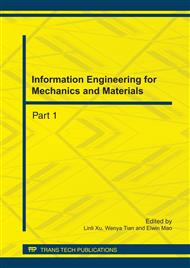[1]
W. M. Yang, Y. M. Ding, P. C. Xie, New Technology of Injection Molding, Chemical Industry Press, Beijing, (2008).
Google Scholar
[2]
Y. P. Lu, Mechanism of forming and controlling means of fusion seam in plastic injection parts, J. MOULD INDUSTRY. 32 (12) (2000) 61-64.
Google Scholar
[3]
W. W. Lin, Study on Forming Mechanism and Control of Weld Line on Large Injection Molding Products, Chongqing University, (2008).
Google Scholar
[4]
J. W. You, The Common Defects of Injection Molding and its Treatment, J. Technology, Economy and Markets. 6(2010) 6-7.
Google Scholar
[5]
L. M. Li, K. K. Lee, K. W. Suen, K. L. Cheng, Technical Handbook for External Gas-assisted Injection Moulding Process, The Hong Kong Productivity Council, Hong Kong, (2003).
Google Scholar
[6]
F. H. Liu, X. Y. Qian and J. Zhang, Development Situation of the New Technology of Injection Molding, J. Technology of Plastic. 37(3) (2009) 83-88.
Google Scholar
[7]
J. W. Wu, Development of plastics injection molding technology, J. China Plastics. 28(3) (2010) 49-54.
Google Scholar
[8]
Kazmer, David, Barkan, Philip, Multi-cavity pressure control in the filling and packing stages of the injection molding process, J. Polymer Engineering and Science. 37(11) (1997) 1865-1879.
DOI: 10.1002/pen.11837
Google Scholar
[9]
X. F. Peng, J. W. Chen, Q. G. Lan and N. Q. Zhou, New Technology of Vibration Gas-assisted Injection Molding for Plastics Parts, J. China Plastics. 19(4)(2005) 1-5.
Google Scholar
[10]
J.P. Ibar, Control of Polymer Properties by Melt Vibration Technology: A Review, J. Polymer Engineering and Science. 38(1) (1998) 1~20.
DOI: 10.1002/pen.10161
Google Scholar
[11]
S. C. Chen, W. R. Jong, J. A. Chang, Dynamic Mold Surface Temperature Control Using Induction Heating and Its Effects on the Surface Appearance of Weld Line. Wiley InterScience, 28 November (2005).
DOI: 10.1002/app.24070
Google Scholar
[12]
D. H. Kim, M. H. Kang, Y. H. Chun, Development of a new injection molding technology: momentary mold surface heating process, J. Journal of Injection Molding Technology. 5(4) (2001) 229-232.
Google Scholar
[13]
D. G. Yao, B. Kim. Development of rapid heating and cooling systems for injection molding applications, J. Polymer Engineering and Science. 42(12) (2002) 2471-2481.
DOI: 10.1002/pen.11133
Google Scholar
[14]
G. L. Wang, G. Q. Zhao, H. P. Li, Y. J Guan, Study of variotherm injection molding technology and analysis on its application, J. Modern Chemical Industry. 29(2) (2009) 24-27.
Google Scholar
[15]
Z. Wang. Widely used of hot runner, J. World Plastics. 27(12) (2009) 57-59.
Google Scholar
[16]
J. L. Chen, J. L. Sun, Calle, Development and Application of Hot Runner Technology in Injection Molding, J. Modern plastics processing and applications. 20(2) (2008) 57-60.
Google Scholar


